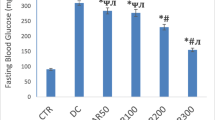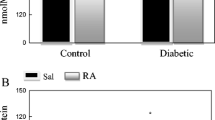Abstract
We have shown that a single dose of streptozotocin (STZ) (50 mg/kg body weight) injected into rats caused significant changes in some antioxidant enzyme activities, such as glutathione peroxidase, glutathione reductase, glutathione-s-transferase, glucose-6-phosphate dehydrogenase, and 6-phosphogluconate dehydrogenase activities, and acid-soluble sulfhydryl levels of the liver tissue with respect to the control rats. Furthermore, these alterations in the activities of the antioxidant enzymes were accompanied by significant changes in the ultrastructure of the liver tissue; mainly intercellular biliary canaliculi were distended and contained stagnant bile, swollen mitochondria in hepatocytes and disoriented and disintegrating cristae, dilatation of the rough endoplasmic reticulum (rER) with detachment of ribosomes, and dissociation of polysomes. Both diabetic and normal rats were treated with sodium selenite (5 μmol/kg/d, intraperitoneally) for 4 wk following 1 wk of diabetes induction. This treatment of diabetic rats improved significantly diabetes-induced alterations in liver antioxidant enzymes. Moreover, treating of diabetic rats with sodium selenite prevented primarily the variation in staining quality of hepatocytes nuclei, increased density and eosinophilia of the cytoplasm, focal sinusoidal dilatation and congestion, and increased numbers of mitochondria with different size and shape. In summary, treatment of diabetic rats with sodium selenite has beneficial effects on both antioxidant system and the ultrastructure of the liver tissue. These findings suggest that diabetes-induced oxidative stress can be responsible for the development of diabetic complications and antioxidant treatment can protect the target organs against diabetes.
Similar content being viewed by others
References
R. A. Hebden, S. M. Gardiner, T. Bennett, and I. A. MacDonald, The influence of streptozotocin-induced diabetes mellitus on fluid and electrolyte handling in rats, Clin. Sci. 70, 111–117 (1986).
D. R. Tomlinson, Polyols and myo-inositol in diabetic neuropathy: of mice and men, Mayo Clin. Proc. 64, 1030–1033 (1989).
B. Mukherjee, S. Anbszhagan, A. Roy, R. Ghosh, and M. Chatterjee, Novel implications of the potential role of selenium on antioxidant status in streptozotocin-induced diabetic mice, Biomed. Pharmacother. 52, 89–95 (1998).
J. W. Baynes, Perspective in diabetes. Role of oxidative stress in development of complications in diabetes, Diabetes 40, 405–412 (1991).
J. W. Baynes, Role of oxidative stress in development of complications in diabetes, Diabetes 40, 405–412 (1991).
J. V. Hunt, C. C. T. Smith, and S. P. Wolf, Autoxidative glycosylation and possible involvement of peroxides and free radicals in LDL modification by glucose, Diabetes 39, 1420–1424 (1990).
R. P. Mason, B. Kalyanaraman, B. E. Tainer, and T. E. Eling, A carbon-centered free radical intermediate in the prostaglandin snynthase oxidation of arachidonic acid, J. Biol. Chem. 255, 5019–5022 (1980).
A. Boveris, Mitochondrial production of superoxide and hydrogen peroxide, Adv. Exp. Med. Biol. 78, 67–82 (1977).
Y. Sagara, R. Dargusch, D. Chambers, J. Davis, D. Schubert, and P. Maher, Cellular mechanisms of resistance to chronic oxidative stress, Free Radical Biol. Med. 24, 1375–1389 (1988).
L. W. Oberley, Free radicals and diabetes, Free Radical Biol. Med. 5, 113–124 (1988).
C. Costagliola, G. Iuliano, A. Menzione, A. Nesti, F. Simonelli, and E. Rinaldi, Systemic human diseases as oxidative risk factor in cataractogenesis, Ophthal. Res. 20, 308–316 (1988).
J. H. McNeill, H. L. M. Delgatty, and M. L. Battell, Insulinlike effects of sodium selenate in streptozotocin-induced diabetic rats, Diabetes 40, 1675–1678 (1991).
C. Furnsinn, R. Englischh, K. Ebner, P. Nowotny, C. Vogle, and W. Waldhausl, Insulinlike vs non-insulin like stimulation of glucose metabolism by vanadium, tungsten and selenium compounds in rat muscle, Life Sci. 59, 1989–2000 (1996).
M. L. Battell, H. L. M. Delgatty, and J. H. McNeill, Sodium selenate corrects glucose tolerance and heart function in STZ diabetic rats, Mol. Cell. Biochem. 179, 27–34 (1998).
C. Gocmen, A. Secilmis, E. K. Kumcu, et al., Effects of vitamin E and sodium selenate on neurogenic and endothelial relaxation of corpus cavernosum in the diabetic mouse, Eur. J. Pharmacol. 398, 93–98 (2000).
O. Ezaki, The insulin-like effects of selenate in rat adipocytes, J. Biol. Chem. 265, 1124–1130 (1990).
Y. Shechter, Insulin-mimetic effects on vanadate. Possible implications for future treatment of diabetes, Diabetes 1, 1–5 (1990).
E. A. Berg, J. Y. Wu, L. Campbell, M. Kagey, and S. R. Stapleton, Insulin-like effects of vanadate and selenate on the expression of glucose-6-phosphate dehydrogenase and fatty acid synthase in diabetic rats, Biochimie 77, 919–924 (1995).
A. M. Kordowiak, A. Nikiforuk, and W. Dabros, Biochemical and morphological study on liver Golgi complex in streptozotocin-diabetic and control rats treated with bis(kojato)oxovanadium (IV) [VO(ka)2]×2H2O. Part I. One week treatment with vanadium compound, Pol. J. Pathol. 51(1), 9–16 (2000).
W. Dabros, R. Grybos, A. Miarka, and A. M. Kordowiak, Biochemical and morphological study on liver Golgi complex in streptozotocin-diabetic and control rats treated with bis(kojato)oxovanadium(IV) [VO(ka)2]×2H2O. Part II. Prolonged treatment with vanadium compound, Pol. J. Pathol. 51(1), 17–24 (2000).
B. K. Saha, R. Bhattacharya, and M. Chatterjee, 1-Alpha, 25-dihydroxyvitamin D(3) inhibits rat liver ultrastructural changes and the development of gamma-glutamyl-transpeptidase-positive foci in diethylnitrosam ine-initiated and streptozotocin-induced diabetes-promoted hepatocarcinogenesis, Cell. Biochem. Function 20(3), 195–204 (2002).
M. Ayaz, B. Can, S. Ozdemir, and B. Turan, Protective effect of selenium treatment on diabetes-induced myocardial structural alterations, Biol. Trace Element Res. 89(3), 215–226 (2002).
C. Delilbasi, S. Demiralp, and B. Turan, Effects of selenium on the structure of the mandible in experimental diabetics, J. Oral Sci. 44(2), 85–90 (2002).
N. L. Acan and E. F. Tezcan, Sheep brain glutathione reductase: purification and general properties, FEBS Lett. 250, 72–74 (1989).
R. A. Lawrence and R. F. Burk, Glutathione peroxidase activity in selenium-deficient rat liver, Biochem. Biophys. Res. Commun. 71, 952–958 (1976).
K. Betke, H. N. Brewer, L. Kirkman, et al., Standardized method for G-6-PD assay of haemolysates, WHO Tech. Rep. Ser. 366, 30–32 (1967).
B. M. F. Pearse and M. A. Rosemeyer, 6-Phosphogluconate dehydrogenase from human erythrocytes, in Methods in Enzymology, Volume 41, S.R. Colowich and N. O. Kaplan, eds., Academic, London, 220 (1975).
W. H. Habig and W. B. Jakott, Glutathione transferase (rat and human), Methods Enzymol. 77, 218–231 (1981).
A. B. Burtis and E. R. Ashwood, eds., Tietz Textbook of Clinical Chemistry, 2nd ed., W. B. Saunders, Philadelphia, pp. 1990–1992 (1994).
M. M. Bradford, A rapid and sensitive method for the quantitation of microgram quantities of protein utilizing the principle of protein dye binding, Anal. Biochem. 72, 248–254 (1976).
E. J. Berly and L. Gillian, Direct determination of selenium of graphite furnace atomic absorption spectrometry with deuterium back ground correction and a reduced palladium modifier: age specific reference ranges, Clin. Chem. 34(4), 709–714 (1988).
S. A. Garfield, S. A. Mohamed, and R. R. Cardell, Jr., The effects of insulin replacement and withdraw al on hepatic ultrastructure and biochemistry, Am. J. Anat. 70(2), 127–142 (1984).
D. J. Becker, B. Reul, A. T. Ozcelikay, J. P. Buchet, J. C. Henquin, and S. M. Brichard, Oral selenate improves glucose homeostasis and partly reverses abnormal expression of liver glycogenic and gluconeogenic enzymes in diabetic rats, Diabetologia 39, 3–11 (1996).
L. H. Foster and S. Sumar, Selenium in health and disease: a review, Crit. Rev. Food. Sci. Nutr. 37, 211–228 (1997).
M. Kashimata, M. Hiramatsu, and N. Mimami, Effect of streptozotocin-induced diabetes on epidermal growth factor receptors in rat liver plasma membrane, Biochim. Biophys. Acta 923(3), 496–500 (1987).
S. E. Lenk, D. Bhat, W. Blakeney, and W. A. Dunn, Jr., Effects of streptozotocin-induced diabetes on rough endoplasmic reticulum and lysosomes of rat liver, Am. J. Physiol. 263(5 Pt. 1), E856-E862 (1992).
M. E. De Paepe, B. Keymeulen, D. Pipeleers, and G. Kloppel, Proliferation and hypertrophy of liver cells surrounding islet grafts in diabetic recipient rats, Hepatology 21(4), 1144–1153 (1995).
T. S. Pillay and M. W. Makgoba, Enhancement of EFG and insulin-stimulated tyrosine phosphorylation of endogenous substrates by sodium selenate, FEBS Lett. 308, 38–42 (1992).
S. R. Stapleton, G. Garlock, L. Foellmi-Adam, and R. F. Kletzien, Selenium: potent stimulator of tyrosyl phosphorylation and activator of MAP kinase, Biochem. Biophys. Acta 1355, 259–269 (1997).
Y. J. Hei, S. Farahbakhshian, X. Chen, M. L. Battell, and J. H. McNeill, Stimulation of MAP kinase and S6 kinase by vanadium and selenium in rat adipocytes, Mol. Cell. Biochem. 178, 367–375 (1998).
G. Wu, Y. Z. Fang, S. Yang, J. R. Lupton, and N. D. Turner, Glutathione metabolism and its implications for health, J. Nutr. 134(3), 489–492 (2004).
H. Sies, Glutathione and its role in cellular functions, Free Radical Biol. Med. 27(9–10), 16–26 (1999).
A. E. Salinas and M. G. Wong, Glutathione S-transferase—a review, Curr. Med. Chem. 6(4), 279–309 (1999).
Y. Fang, S. Yang, and G. Wu, Free radicals, antioxidants, and nutrition, Nutrition 18, 872–879 (2002).
J. T. Rotruck, A. L. Pope, H. E. Ganther, A. B. Swanson, D. G. Hafemen, and W. G. Hoekstra, Selenium: biochemical role as a component of glutathione peroxidase, Science 149, 588–590 (1973).
I. C. West, Radicals and oxidative stress in diabetes, Diabet. Med. 17, 171–180 (2000).
G. Fitzl, R. Martin, D. Dettmer, V. Hermsdorf, H. Drews, and K. Welt, Protective effects of Ginkgo biloba extract EGb 761 on the myocardium of experimentally diabetic rats. I. Ultrastructural and biochemical investigation on cardiomyocytes, Exp. Toxicol. Pathol. 51(3), 189–198 (1999).
L. J. Coppey, J. S. Gellett, E. P. Davidson, J. A. Dunlap, D. D. Lund, and M. A. Yorek, Effect of antioxidant treatment of streptozotocin-induced diabetic rats on endoneurial blood flow, motor nerve conduction velocity, and vascular reactivity of epineurial arterioles of the sciafic nerve, Diabetes 50, 1927–1937 (2001).
Author information
Authors and Affiliations
Rights and permissions
About this article
Cite this article
Can, B., Ulusu, N.N., Kilinç, K. et al. Selenium treatment protects diabetes-induced biochemical and ultrastructural alterations in liver tissue. Biol Trace Elem Res 105, 135–150 (2005). https://doi.org/10.1385/BTER:105:1-3:135
Received:
Accepted:
Issue Date:
DOI: https://doi.org/10.1385/BTER:105:1-3:135




